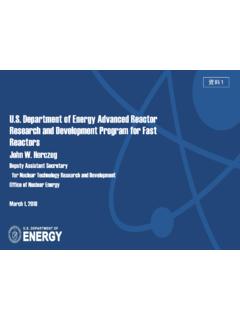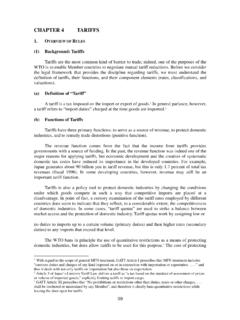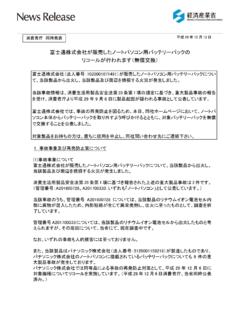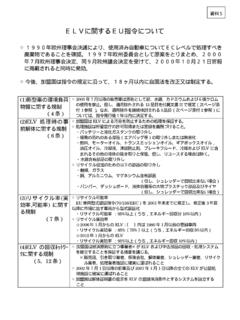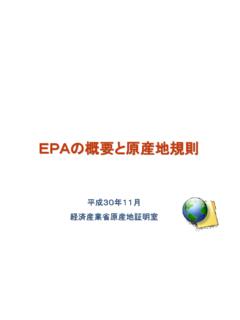Transcription of Summary of the Strategic Road Map for Hydrogen and …
1 Provisional Translation Summary of the Strategic road Map for Hydrogen and Fuel Cells June 23, 2014 . Agency for Natural Resources and Energy Summary of the Strategic road Map for Hydrogen and Fuel Cells (1). Overview . Significance of realizing a Hydrogen society 1. Energy conservation Making use of fuel cells to realize high energy efficiency, leading to achievement of dramatic energy conservation Hydrogen is a resource that could enhance energy security if the following advantages are leveraged and the applicable scope of the resource is expanded.
2 [i] the ingredients of Hydrogen are highly interchangeable with other materials, and Hydrogen can be manufactured with various methods from many kinds of substitute materials, such as various primary energy sources including unutilized energy resources ( , by-product 2. Energy security Hydrogen , crude oil associated gas and lignite) and renewable energy; and [ii] in the future, such energy may be procured inexpensively from regions with low geopolitical risk, and utilizing Hydrogen manufactured from renewable energy in Japan may also increase the energy self- sufficiency rate in the future.
3 3. Reducing environmental When used as an energy source, Hydrogen does not emit carbon dioxide. Taking advantage of this characteristic, combining the technology for manufacturing Hydrogen with a carbon capture and storage (CCS) process, or with making use of Hydrogen derived from any renewable energy, burdens will lead to the reduction of environmental burdens and even to the full elimination of carbon dioxide. 4. Promoting industries and Japan has strong global competitiveness in the field of fuel cells. For example, Japan has filed the world's largest number of patent applications for the technology five times the number of those filed by second or lower-placed countries , leaving other countries far behind.
4 In addition, revitalizing regional economies Japan's regional resources, , renewable energy, can be utilized to manufacture Hydrogen for fuel cells. Future direction for the measures for realizing a Hydrogen society To realize a Hydrogen society, related systems will be formulated on a large scale, which may be accompanied by changes in the current social structure, and long-term, continuous measures for realizing such a society will be taken. In addition, the imbalance between supply side and demand side issues will be resolved, while academia, government and industry will collaborate to proactively engage in measures for utilizing Hydrogen .
5 To achieve this goal, Japan will aim to achieve a Hydrogen society through the following step-by-step process: Phase 1 (Dramatic expansion of Hydrogen use) : Dramatically expanding the use of stationary fuel cells and fuel cell vehicles, which are in the process of being realized, leading to the successful acquisition of a global market in the field of Hydrogen and fuel cells, in which Japan leads the world;. Phase 2 (Full-fledged introduction of Hydrogen power generation/Establishment of a large-scale system for supplying Hydrogen ) : Further expanding the demand for Hydrogen , while widening the scope of Hydrogen sources to include unutilized energy, so as to establish a new secondary energy structure in which Hydrogen will be added to existing resources, namely electricity and heat (gas).
6 And Phase 3 (Establishment of a zero-carbon emission Hydrogen supply system throughout the manufacturing process) : Combining the technology for manufacturing Hydrogen with a CCS process, or with making use of Hydrogen derived from a renewable energy resource, so as to establish a zero-carbon-emission system for supplying Hydrogen throughout the manufacturing process. Phase 1 Phase 2 Phase 3. Dramatic expansion of Hydrogen use Full-fledged introduction of Hydrogen power generation/ Establishment of a zero-carbon emission Hydrogen (Full-fledged introduction of fuel cells into society) Establishment of a large-scale system for supplying Hydrogen supply system throughout the manufacturing process Release onto the market: residential fuel cells in 2009; Fuel cell vehicles in 2015 Accelerating development and demonstration Establishing a Strategic partnership with Hydrogen -suppliers overseas 2017.
7 Releasing fuel cells for commercial and industrial Realizing inexpensive Hydrogen , anticipating growth in demand use onto the market 2020. Conveying to the world Around 2020. Achieving a reduction of Hydrogen price to a level Mid 2020s Systematic development and demonstration the information on the -Plant delivery price of Hydrogen from overseas: 30 yen/Nm3 of such a system, based on its potential for potential of Hydrogen by equal to or lower than that of fuels for hybrid -Building up a commercial-based domestic system for efficiently taking advantage of the vehicles distributing Hydrogen development 2020 Summer Olympic Games in Tokyo Around 2025 Around 2030.
8 2030 Fuel cell vehicles: Achieving a reduction of vehicle prices to the level of hybrid vehicles of the same -Full-fledged operation of manufacturing, transportation and storage of Hydrogen derived from unutilized energy resources imported from overseas class and price range - Full-fledged introduction of Hydrogen power generation for power- producing business Around 2040. Full-fledged operation of manufacturing, transportation and storage 2040 of zero-carbon emission Hydrogen , by combining the manufacturing technology with a CCS process or with making use of domestic and overseas renewable energy Market scale of the equipment and infrastructure businesses related to Hydrogen and fuel cells in Japan Approx.
9 1 trillion yen in 2030 Approx. 8 trillion yen in 2050. Summary of the Strategic road Map for Hydrogen and Fuel Cells (2) Note: Pink arrows refer to initiatives led by the government and blue arrows refer to initiatives led by the private sector. Chart for all fields . Around 2015 Around 2020 Around 2030 Around 2040. Phase 1: Dramatic expansion of the Hydrogen use (full-fledged introduction of fuel cells into society). Stationary Achieving a cost reduction allowing a user Achieving a cost reduction allowing a user to fuel cells to recoup the investment within 7 or 8 recoup the investment within 5 years Residential Commercial Current years Supporting use situation introduction of such fuel cells Further dissemination of commercially-viable fuel cells for residential use Brought to the market in Utilization of Hydrogen 2009 with more than Releasing such fuel cells for commercial and industrial use to the market in 2017.
10 And industrial 70,000 disseminated Demonstration for commercialization Further dissemination of commercially-viable fuel cells for commercial and industrial use use and reviewing regulations Fuel cell vehicles Achieving a reduction of vehicle price to the level of hybrid vehicles of the same class and price range Current situation [i] Supporting businesses introducing such vehicles Releasing passenger [ii] Developing technology for reducing costs and enhancing Further dissemination of commercially-viable fuel cell vehicles (aiming at the cars onto the market by the durability of such vehicles world's quickest dissemination of the vehicles).
